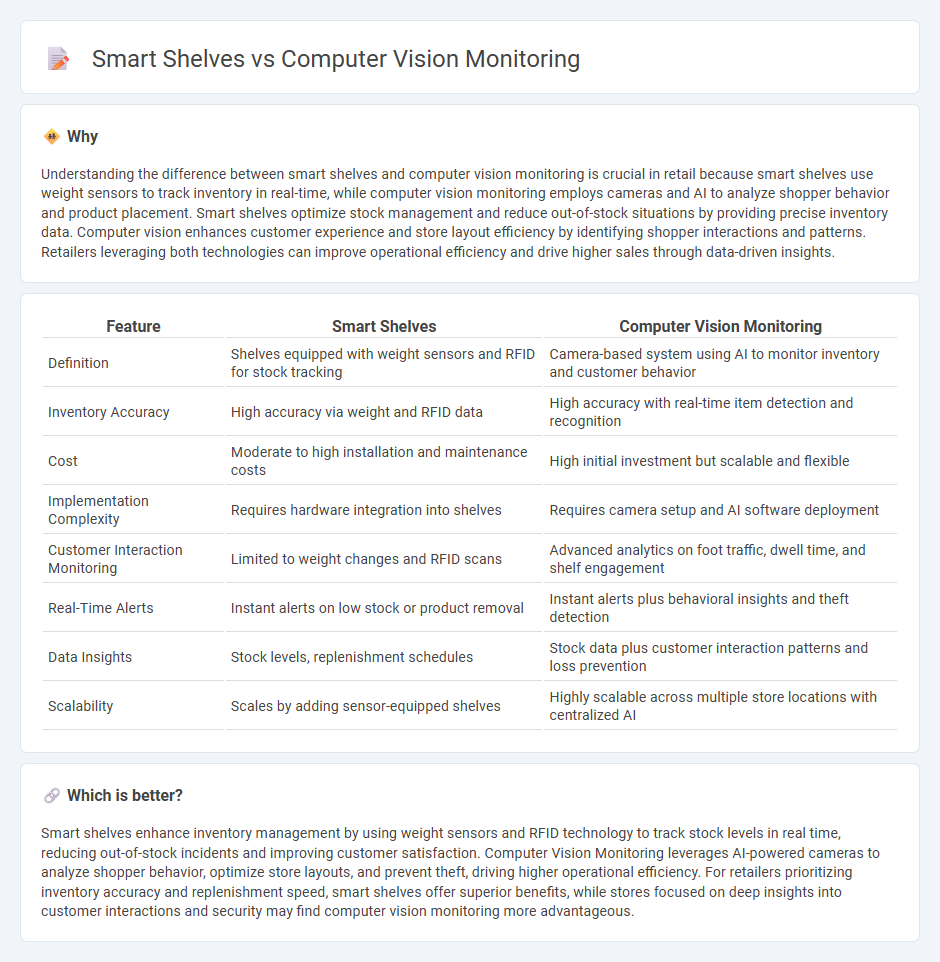
Smart shelves leverage embedded sensors and RFID technology to track inventory in real-time, enhancing stock accuracy and customer experience. Computer vision monitoring employs AI-powered cameras to analyze shopper behavior and detect product placement issues without physical tags. Explore the latest innovations in retail technology to transform your store operations.
Why it is important
Understanding the difference between smart shelves and computer vision monitoring is crucial in retail because smart shelves use weight sensors to track inventory in real-time, while computer vision monitoring employs cameras and AI to analyze shopper behavior and product placement. Smart shelves optimize stock management and reduce out-of-stock situations by providing precise inventory data. Computer vision enhances customer experience and store layout efficiency by identifying shopper interactions and patterns. Retailers leveraging both technologies can improve operational efficiency and drive higher sales through data-driven insights.
Comparison Table
| Feature | Smart Shelves | Computer Vision Monitoring |
|---|---|---|
| Definition | Shelves equipped with weight sensors and RFID for stock tracking | Camera-based system using AI to monitor inventory and customer behavior |
| Inventory Accuracy | High accuracy via weight and RFID data | High accuracy with real-time item detection and recognition |
| Cost | Moderate to high installation and maintenance costs | High initial investment but scalable and flexible |
| Implementation Complexity | Requires hardware integration into shelves | Requires camera setup and AI software deployment |
| Customer Interaction Monitoring | Limited to weight changes and RFID scans | Advanced analytics on foot traffic, dwell time, and shelf engagement |
| Real-Time Alerts | Instant alerts on low stock or product removal | Instant alerts plus behavioral insights and theft detection |
| Data Insights | Stock levels, replenishment schedules | Stock data plus customer interaction patterns and loss prevention |
| Scalability | Scales by adding sensor-equipped shelves | Highly scalable across multiple store locations with centralized AI |
Which is better?
Smart shelves enhance inventory management by using weight sensors and RFID technology to track stock levels in real time, reducing out-of-stock incidents and improving customer satisfaction. Computer Vision Monitoring leverages AI-powered cameras to analyze shopper behavior, optimize store layouts, and prevent theft, driving higher operational efficiency. For retailers prioritizing inventory accuracy and replenishment speed, smart shelves offer superior benefits, while stores focused on deep insights into customer interactions and security may find computer vision monitoring more advantageous.
Connection
Smart shelves utilize embedded sensors and RFID technology to track inventory levels in real-time, while computer vision monitoring employs cameras and AI algorithms to analyze shelf conditions and customer interactions. Together, these technologies enhance inventory accuracy, reduce stockouts, and optimize product placement by providing continuous, automated insights into retail environments. The integration of smart shelves with computer vision drives efficient shelf management, improving both operational efficiency and the shopping experience.
Key Terms
Object Detection
Computer vision monitoring leverages advanced algorithms to identify and track objects in real-time, enabling comprehensive surveillance across various environments, while smart shelves utilize embedded sensors and computer vision specifically to detect product presence and stock levels in retail settings. Both technologies rely heavily on object detection models such as YOLO, SSD, or Faster R-CNN for accuracy in recognizing items and ensuring operational efficiency. Explore our in-depth analysis to understand how these object detection techniques enhance inventory management and security applications.
Planogram Compliance
Computer vision monitoring enables real-time analysis of store shelves to ensure products are arranged according to established planograms, improving accuracy and reducing manual audits. Smart shelves use weight sensors and RFID technology to detect product placement and stock levels, offering automated compliance verification but limited visual context. Explore how these technologies enhance retail planogram compliance and drive operational efficiency.
Inventory Tracking
Computer vision monitoring leverages advanced image recognition algorithms to provide real-time inventory tracking with high accuracy and minimal human intervention, capturing detailed product data and shelf status. Smart shelves utilize weight sensors and RFID technology to detect stock levels and product movement, primarily focusing on automated restocking alerts and theft prevention. Explore how these technologies transform inventory management efficiency and accuracy in retail environments.
Source and External Links
What is Computer Vision? - Image recognition AI/ML ... - Computer vision technology enables machines to automatically recognize and describe images efficiently, used in monitoring for security, safety, operational efficiency, and real-time alerts in various settings.
Computer Vision Platform: Real-Time Monitoring with AI - Eviden offers an AI-powered video analytics platform providing real-time monitoring, precise object tracking, alarm triggering, and tailored classification to enhance security, safety, and operations.
Popular applications of computer vision in site security - Computer vision in surveillance applies AI and edge computing to automate security monitoring by processing video data locally on cameras to detect threats with low latency and high privacy.
 dowidth.com
dowidth.com